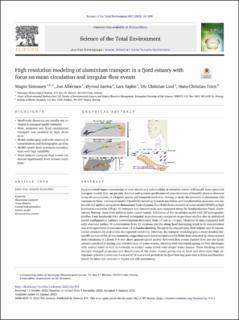| dc.contributor.author | Simonsen, Magne | |
| dc.contributor.author | Albretsen, Jon | |
| dc.contributor.author | Sætra, Øyvind | |
| dc.contributor.author | Asplin, Lars | |
| dc.contributor.author | Lind, Ole Christian | |
| dc.contributor.author | Teien, Hans-Christian | |
| dc.date.accessioned | 2023-10-11T13:54:18Z | |
| dc.date.available | 2023-10-11T13:54:18Z | |
| dc.date.created | 2023-03-21T16:11:07Z | |
| dc.date.issued | 2023 | |
| dc.identifier.citation | Science of the Total Environment. 2023, 867 . | en_US |
| dc.identifier.issn | 0048-9697 | |
| dc.identifier.uri | https://hdl.handle.net/11250/3095855 | |
| dc.description.abstract | Environmental impact assessments of trace metals and radionuclides in estuarine waters will benefit from numerical transport models that can provide detailed and accurate predictions of concentrations of harmful physico-chemical forms of contaminants at adequate spatial and temporal resolution. Aiming to study the potential of aluminium (Al) exposure to biota, a transport model (OpenDrift) including dynamic speciation and transformation processes was improved and applied, using three-dimensional hydrodynamic flow fields from a numerical ocean model (ROMS) at high horizontal resolution (32 m). Al transport and concentration was computed along the Sandnesfjorden Fjord, south-eastern Norway, from river outlet to open coastal waters. Validation of the circulation model with 29 hydrographic profiles from Sandnesfjorden showed substantial improvements compared to previous studies due to optimized model configuration (salinity overestimation decreased from >7 psu to <4 psu). Modeled Al data compared well with observed surface Al concentration from 12 locations and the along-fjord decreasing trend in Al-concentration was well reproduced (error ratios were <2 in Sandnesfjorden). Except in the channel area, both salinity and Al concentration estimates lie well within the expected variability. However, the transport modeling gave a more detailed site-specific picture of the Al concentration, suggesting more scattered and variable fields than indicated by observational data (variations of a factor 3–4 over short spatiotemporal scales). Reversed flow events (surface flow into the fjord) caused considerable mixing and redistribution of water masses, affecting both horizontal mixing of river discharges with coastal water as well as vertically as surface water mixed with deeper water masses. These blocking events strongly changed properties and distribution of the water masses giving rise to local and short-term high Al-exposure episodes (variations of a factor of 10 over a 12 h period) in the fjord that may pose risks to biota and therefore should be taken into account in impact and risk assessments. | en_US |
| dc.language.iso | eng | en_US |
| dc.title | High resolution modeling of aluminium transport in a fjord estuary with focus on mean circulation and irregular flow events | en_US |
| dc.title.alternative | High resolution modeling of aluminium transport in a fjord estuary with focus on mean circulation and irregular flow events | en_US |
| dc.type | Peer reviewed | en_US |
| dc.type | Journal article | en_US |
| dc.description.version | publishedVersion | en_US |
| dc.source.pagenumber | 17 | en_US |
| dc.source.volume | 867 | en_US |
| dc.source.journal | Science of the Total Environment | en_US |
| dc.identifier.doi | 10.1016/j.scitotenv.2023.161399 | |
| dc.identifier.cristin | 2135894 | |
| dc.relation.project | Norges forskningsråd: 223268 | en_US |
| cristin.ispublished | true | |
| cristin.fulltext | original | |
| cristin.qualitycode | 2 | |
